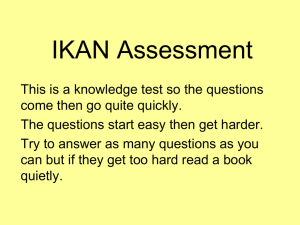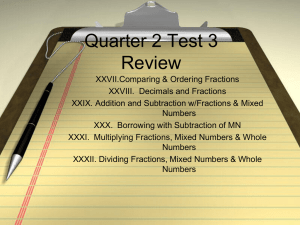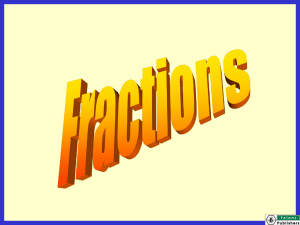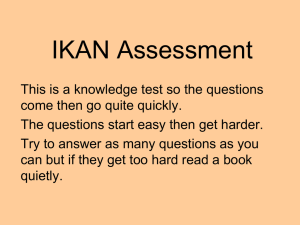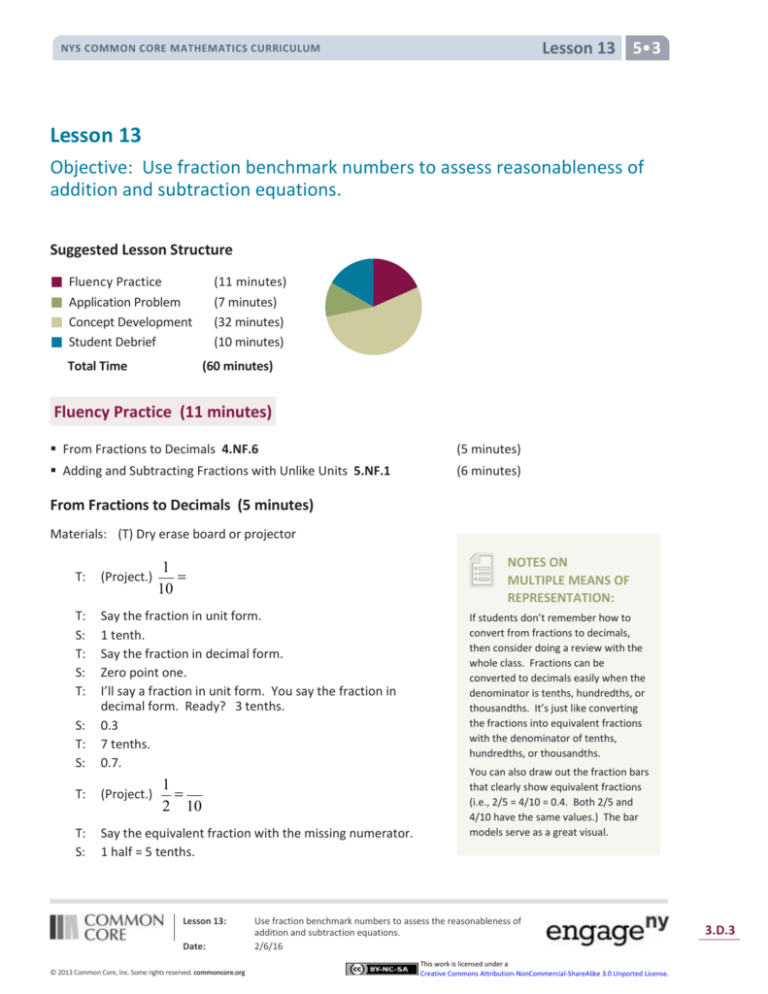
5•3
Lesson 13 Lesson
NYS COMMON CORE MATHEMATICS CURRICULUM
Lesson 13
Objective: Use fraction benchmark numbers to assess reasonableness of
addition and subtraction equations.
Suggested Lesson Structure
Fluency Practice
Application Problem
Concept Development
Student Debrief
Total Time
(11 minutes)
(7 minutes)
(32 minutes)
(10 minutes)
(60 minutes)
Fluency Practice (11 minutes)
From Fractions to Decimals 4.NF.6
(5 minutes)
Adding and Subtracting Fractions with Unlike Units 5.NF.1
(6 minutes)
From Fractions to Decimals (5 minutes)
Materials: (T) Dry erase board or projector
NOTES ON
MULTIPLE MEANS OF
REPRESENTATION:
1
=
10
T:
(Project.)
T:
S:
T:
S:
T:
Say the fraction in unit form.
1 tenth.
Say the fraction in decimal form.
Zero point one.
I’ll say a fraction in unit form. You say the fraction in
decimal form. Ready? 3 tenths.
0.3
7 tenths.
0.7.
S:
T:
S:
1
T: (Project.)
=
2 10
T:
S:
Say the equivalent fraction with the missing numerator.
1 half = 5 tenths.
Lesson 13:
Date:
© 2013 Common Core, Inc. Some rights reserved. commoncore.org
If students don’t remember how to
convert from fractions to decimals,
then consider doing a review with the
whole class. Fractions can be
converted to decimals easily when the
denominator is tenths, hundredths, or
thousandths. It’s just like converting
the fractions into equivalent fractions
with the denominator of tenths,
hundredths, or thousandths.
You can also draw out the fraction bars
that clearly show equivalent fractions
(i.e., 2/5 = 4/10 = 0.4. Both 2/5 and
4/10 have the same values.) The bar
models serve as a great visual.
Use fraction benchmark numbers to assess the reasonableness of
addition and subtraction equations.
2/6/16
This work is licensed under a
Creative Commons Attribution-NonCommercial-ShareAlike 3.0 Unported License.
3.D.3
5•3
Lesson 13 Lesson
NYS COMMON CORE MATHEMATICS CURRICULUM
T:
S:
T:
S:
T:
S:
Say 5 tenths as a decimal.
0.5
Say 1 half as a decimal.
0.5
Say 3 and 1 half as a decimal.
3.5.
Repeat process for possible sequence:
1 2 4 4 1 3 3 1 2 3
3 1 11 11 1 3
3
, , ,2 , , ,5 , , , ,5 , , ,3 , , ,4
5 5 5 5 4 4 4 25 25 25 25 20 20 20 50 50 50
Adding and Subtracting Fractions with Unlike Units (6 minutes)
Materials: (S) Personal white boards
T:
(Write.)
1 1 2
+ =
4 2 6
T:
S:
T:
True or false?
False.
On your personal white boards, write the answer that
will make the addition sentence true.
S:
(Write.)
T:
(Project.)
T:
S:
T:
True or false?
True.
Rewrite the addition sentence using like units.
S:
(Write.)
1 1 1 2 3
+ = + =
4 2 4 4 4
1 3 7
+ =
2 8 8
NOTES ON
MULTIPLE MEANS OF
ENGAGEMENT:
Provide think time for students to
process the problem before answering
true or false. If necessary, you might
also give another few seconds for
students to discuss the problem with
their partners. Perhaps have them
explain to their partners why they
think a problem is true or false. This
pausing allows gives them the time
they need to own their ideas.
1 3 4 3
+ = +
2 8 8 8
7
=
8
Lesson 13:
Date:
© 2013 Common Core, Inc. Some rights reserved. commoncore.org
Use fraction benchmark numbers to assess the reasonableness of
addition and subtraction equations.
2/6/16
This work is licensed under a
Creative Commons Attribution-NonCommercial-ShareAlike 3.0 Unported License.
3.D.4
5•3
Lesson 13 Lesson
NYS COMMON CORE MATHEMATICS CURRICULUM
2 2 4
3 9 9
T:
(Project.)
T:
S:
T:
True or false?
True.
Rewrite the subtraction sentence using like units.
S:
(Write.)
2 2 6 2
- = 3 9 9 9
4
=
9
5 2 3
6 3 3
T:
(Project.)
T:
S:
T:
S:
True or false?
False.
Write the answer that will make the subtraction sentence true.
(Write.)
5 2 5 4
- = 6 3 6 6
1
=
6
Application Problem (7 minutes)
Mark jogged 3 5/7 km. His sister jogged 2 4/5 km. How much
farther did Mark jog than his sister?
Remind students to approach the problem with the RDW
strategy. This is a very brief Application Problem. As you
circulate while students work, quickly assess which work you
will select for a short two or three minute debrief.
Concept Development (32 minutes)
T:
Look at this problem. Tell your partner how you would
solve it. (Display the problem and allow 30 seconds for
discussion.)
1 3
+
2 4
Lesson 13:
Date:
© 2013 Common Core, Inc. Some rights reserved. commoncore.org
Use fraction benchmark numbers to assess the reasonableness of
addition and subtraction equations.
2/6/16
This work is licensed under a
Creative Commons Attribution-NonCommercial-ShareAlike 3.0 Unported License.
3.D.5
5•3
Lesson 13 Lesson
NYS COMMON CORE MATHEMATICS CURRICULUM
T:
(After listening to partner sharing.) For the past two
weeks we have been learning different strategies to
add and subtract unlike fractions. Today we will focus
on mental math—using reasoning without actually
solving using paper and pencil.
Problem 1
1 3
+
2 4
T:
S:
T:
S:
S:
NOTES ON
MULTIPLE MEANS OF
REPRESENTATION:
If students are not ready to estimate
the sum or difference of a fraction
sentence, consider doing a mini prelesson or a fluency activity on
estimating a single fraction before
moving onto this lesson.
Think about this expression without solving it using
For example:
paper and pencil. Share your analysis with a partner.
1. Is 3/4 closer to 0, 1/2, or 1 whole?
2. Is 2/7 closer to 0, 1/2, or 1 whole?
1/2 could be 50% of something or 50 cents of a dollar.
3. Is 9/10 closer to 0, 1/2, or 1
I know that 1/2 is the same as 5 tenths or 0.5 as a
whole?
decimal. I know 1/2 is more than half because half of
4. Is 1 6/7 closer to 1, 1 1/2, or 2?
a whole is 2 fourths. 3/4 is the same as 75%, just like
5. Is 3 4/7 closer to 3, 3 1/2, or 4?
money. 3 quarters equal 75 cents.
If necessary, write each fraction on a
What do you know about the total value of this expression
sentence strip (using it as a number
without solving?
line) and label it. This way, students
Since 3/4 is more than half and we need to add 1/2 more,
can easily see whether the fraction is
the answer will be greater than 1.
closer to 0, 1/2, or 1 whole.
1 3
+ >1
2 4
It’s like adding 50 cents and 75 cents. The answer will be more than 1 dollar. 1/2 + 2/4 = 1, but
there’s still a leftover of 1/4. The total answer is 1 1/4.
Lesson 13:
Date:
© 2013 Common Core, Inc. Some rights reserved. commoncore.org
Use fraction benchmark numbers to assess the reasonableness of
addition and subtraction equations.
2/6/16
This work is licensed under a
Creative Commons Attribution-NonCommercial-ShareAlike 3.0 Unported License.
3.D.6
5•3
Lesson 13 Lesson
NYS COMMON CORE MATHEMATICS CURRICULUM
Problem 2
2 2
1 −
5 3
T:
S:
T:
S:
Without calculating, what do you know about value of
this expression? Talk to your partner.
I see that it’s a subtraction problem. 2/5 is less than
1/2 and 2/3 is more than 1/2. I know that 2/3 can’t
be subtracted from 2/5 because 2/3 is larger, so we’ll
need to subtract from 1 whole. I can convert 1 2/5
to 7/5 in my head.
Do you think the answer is more than 1 or less than 1?
Turn and share.
2 2
1 − <1
5 3
Less than 1 because 1/5 is less than 1/3 so 2/5 is less
than 2/3. The answer is less than 1 because I can
create equivalent fractions in my head and solve. 1/5 =
3/15, 1/3 =5/15, 3/15 + 5/15 = 8/15.
NOTES ON
MULTIPLE MEANS OF
ENGAGEMENT:
When students are solving problems
with partners and continue to struggle
even with guided questions, consider
asking them to use personal boards to
draw a number line. They can use it to
estimate one fraction at a time, then
estimate the final answer.
For example:
4/10 + 1/3
Draw a number line for 4/10 4/10 ≈
less than 1 half.
Draw a number line for 1/3 1/3 ≈
less than 1 half.
Less than 1/2 + less than 1/2 < 1
4/10 + 1/3 < 1
Problem 3
4 1
+
10 3
T:
Use reasoning skills decide if the answer is more than 1
or less than 1/2. Work with your partner.
Allow a minute for students to analyze and discuss the problem.
Circulate and listen. If students seem to be lost or off track with
their thinking, then you might use some of the following
questions:
Is 4/10 more than 1 half or less than 1 half?
Is 4/10 closer to 0 or 1 whole?
What’s half of 10 tenths?
What’s 4/10 as a decimal?
How much money is 4 tenths?
Is 1/3 closer to 0 or 1 whole?
Is 1/3 more than 1 half or less than 1 half?
Lesson 13:
Date:
© 2013 Common Core, Inc. Some rights reserved. commoncore.org
NOTES ON
MULTIPLE MEANS OF
ENGAGEMENT:
Because both addends are clearly less
than half, this is an easy question. For
advanced students, let them determine
if 3/10 + 2/3 is less than, equal to, or
greater than 1. Encourage them NOT
to solve the problem until they have
determined their reasoning.
Use fraction benchmark numbers to assess the reasonableness of
addition and subtraction equations.
2/6/16
This work is licensed under a
Creative Commons Attribution-NonCommercial-ShareAlike 3.0 Unported License.
3.D.7
Lesson 13 5•3
NYS COMMON CORE MATHEMATICS CURRICULUM
Problem 4
4 2
+
10 9
T:
S:
T:
S:
T:
NOTES ON
MULTIPLE MEANS OF
ENGAGEMENT:
Share your analysis of this expression with your
Below grade level: Try 4/10 + 1/9,
partner.
which is more obviously less than 1/2.
I see that it’s an addition problem. 4/10 is less than
Above grade level: Try 3/10 + 3/9.
1/2, because 4/10 = 0.4. I agree. I also noticed that
2/9 is less than 1 half because half of 9 is 4.5, and 2 is
less than 4.5. Both fractions are closer to 0 than
closer to 1 whole.
Is the answer less than or greater than 1 half?
4 tenths is really close to a half. It only needs 1/10 to be one half. I’m asking myself: Is 2/9
greater than 1/10? If it is, the answer will be greater than 1/2. 2/9 has to be greater than 1/10
because it’s close to 1 fourth or 2/8.
Verify to see.
4 2
+ > 1/2
10 9
Problem 5
4 9
1 −
7 10
T:
S:
T:
S:
S:
NOTES ON
MULTIPLE MEANS OF
ENGAGEMENT:
Below grade level: Try 1 4/7 – 1 first.
Think about this expression with your partner.
Above grade level: Try 1 3/7 – 9/10.
4/7 is more than 1/2, and 9/10 is 1/10 away from 1
whole. I know that 9/10 can’t be subtracted from
4/7, because 9/10 is larger, so we’ll need to subtract
from 1 whole. I would use 1 – 9/10 = 1/10. I
agree. Now we have a leftover of 1/10 + 5/7.
Is the value of this expression greater than or less than 1/2?
I think it’s more than 1 half because I know 4/7 alone is already more than 1 half.
1 less than 1 and 4/7 is going to be more than half. 9/10 is less than 1, so 9/10 less than 1 and 4/7
is going to be greater than 1/2.
5 9
1 −
> 1/2
7 10
Lesson 13:
Date:
© 2013 Common Core, Inc. Some rights reserved. commoncore.org
Use fraction benchmark numbers to assess the reasonableness of
addition and subtraction equations.
2/6/16
This work is licensed under a
Creative Commons Attribution-NonCommercial-ShareAlike 3.0 Unported License.
3.D.8
5•3
Lesson 13 Lesson
NYS COMMON CORE MATHEMATICS CURRICULUM
Problem 6
T:
4 1
−
5 8
Reason about this problem with your partner. Is the value of the expression more than 1/2 or less?
Use the following questions to support:
Is 4/5 more than 1 half or less than 1 half?
Is 4/5 closer to 0 or 1 whole?
What’s half of 5 fifths?
Can you convert 4 fifths to tenths or a decimal in your head? What is it?
Is 1/8 more than 1 half or less than 1 half?
Is 1/8 closer to 0 or 1 whole?
4 1
− > 1/2
5 8
Problem 7
1
1
7
2 + 3 ______6 +
3
5
8
S:
I first need to estimate the total for both equations, then I can compare them. I’ll first add up the
whole numbers on the left, then compare them because they’re the larger place values. If the
wholes are equal, then I’ll estimate the fractions and compare them.
Allow two minutes for students to analyze and discuss the problem. Circulate and listen. If students seem to
be lost or off track with their thinking, use the following questions to guide discussion and thinking. What do
you think about 2 1/3 and 3 1/5?
What’s the total of the whole numbers on the left?
How do you compare the whole numbers?
What do you think about 1/3 and 1/5?
Are 1/3 and 1/5 closer to 0 or 1 whole?
What is your estimation of 1/3 + 1/5? More than 1 or less than 1?
Lesson 13:
Date:
© 2013 Common Core, Inc. Some rights reserved. commoncore.org
Use fraction benchmark numbers to assess the reasonableness of
addition and subtraction equations.
2/6/16
This work is licensed under a
Creative Commons Attribution-NonCommercial-ShareAlike 3.0 Unported License.
3.D.9
5•3
Lesson 13 Lesson
NYS COMMON CORE MATHEMATICS CURRICULUM
Is 7/8 closer to 0 or 1 whole?
What’s 6 + 7/8 equal to?
1
1
7
2 +3 < 6+
3
5
8
Problem 8
Have students work in partners or individually for the last
problem, and then review as a class.
9
1
1 2
4 − 1 ______ 2 +
10
8
2 7
Solution:
NOTES ON
MULTIPLE MEANS OF
ACTION AND
EXPRESSION:
ELLs and students with disabilities
might require more examples and
more time to process. If necessary,
when the class is working on classwork
independently, pull out a small group
to do more examples.
Allow students to use the actual
fraction pieces to estimate if you have
them. If not, allow them to draw out
the fractions on personal white boards.
Problem Set (12 minutes)
Students should do their personal best to complete the
Problem Set within the allotted 12 minutes. For some
classes, it may be appropriate to modify the assignment by
specifying which problems they work on first. Some
problems do not specify a method for solving. Students
solve these problems using the RDW approach used for
Application Problems.
Student Debrief (10 minutes)
Lesson Objective: Use fraction benchmark numbers to
assess the reasonableness of addition and subtraction
equations.
The Student Debrief is intended to invite reflection and
active processing of the total lesson experience.
Invite students to review their solutions for the Problem
Set. They should check work by comparing answers with a
partner before going over answers as a class. Look for
misconceptions or misunderstandings that can be
addressed in the Debrief. Guide students in a
conversation to debrief the Problem Set and process the
lesson.
T:
Bring your Problem Set to the Debrief. Share,
Lesson 13:
Date:
© 2013 Common Core, Inc. Some rights reserved. commoncore.org
Use fraction benchmark numbers to assess the reasonableness of
addition and subtraction equations.
2/6/16
This work is licensed under a
Creative Commons Attribution-NonCommercial-ShareAlike 3.0 Unported License.
3.D.10
5•3
Lesson 13 Lesson
NYS COMMON CORE MATHEMATICS CURRICULUM
S:
T:
T:
S:
T:
check, and/or explain your answers to your partner.
(Students work together for 2 minutes. Circulate and listen to explanations. Analyze the work you see
to determine which student solutions you will display to support your lesson objective.)
(Go over answers or select individual students to explain the thinking process that led them to a correct
answer.)
What did you learn today? Turn and share with your partner.
I can use my reasoning skills to estimate fraction answers. When I estimate fraction answers, I
should be thinking about how that fraction is closer to 0, 1/2, or 1 whole. That’ll make it easier for me
to do mental math. I learned to estimate fractions and answers mentally. It reminds me of
rounding. If I’m adding 2 fractions that are more than 1/2, then the answer will be more than 1 whole.
(Optional as time allows. The following is a suggested list of questions to invite reflection and active
processing of the total lesson experience. Use those that resonate for you as you consider what will
best support your students’ ability to articulate the focus of the lesson.)
Why do mathematicians agree it is wise to estimate before calculating?
Think about what happens to your reasoning when you are calculating.
Why do mathematicians agree it is wise to estimate after calculating?
Exit Ticket (3 minutes)
After the Student Debrief, instruct students to complete the Exit Ticket. A review of their work will help you
assess the students’ understanding of the concepts that were presented in the lesson today and plan more
effectively for future lessons. You may read the questions aloud to the students.
Lesson 13:
Date:
© 2013 Common Core, Inc. Some rights reserved. commoncore.org
Use fraction benchmark numbers to assess the reasonableness of
addition and subtraction equations.
2/6/16
This work is licensed under a
Creative Commons Attribution-NonCommercial-ShareAlike 3.0 Unported License.
3.D.11
NYS COMMON CORE MATHEMATICS CURRICULUM
Name
Lesson 13 Problem Set 5•3
Date
1. Are the following greater than or less than 1? Circle the correct answer.
a)
1
2
+7
2
b)
5
8
+5
3
1
1
c) 1 4 − 3
5
5
d) 3 8 − 2 9
greater than 1
less than 1
greater than 1
less than 1
greater than 1
less than 1
greater than 1
less than 1
2. Are the following greater than or less than 1/2? Circle the correct answer.
a)
1
4
+3
2
greater than
1
2
less than
1
2
b)
3
7
−
1
8
greater than
1
2
less than
1
2
greater than
1
2
less than
1
2
greater than
1
2
less than
1
2
1
7
c) 1 7 − 8
d)
3
7
2
+6
3. Use > , < , or = to make the following statements true.
2
3
2
1
5
2
5
Lesson 13:
Use fraction benchmark numbers to assess the reasonableness of
addition and subtraction equations.
2/6/16
a) 5 3 + 3 4 _______ 8 3
2
b) 4 8 − 3 5 _______ 1 8 + 5
Date:
© 2013 Common Core, Inc. Some rights reserved. commoncore.org
3
13
c) 5 2 + 1 7 _______ 6 + 14
4
2
4
2
d) 15 7 − 11 5 _______ 4 7 + 5
This work is licensed under a
Creative Commons Attribution-NonCommercial-ShareAlike 3.0 Unported License.
3.D.12
NYS COMMON CORE MATHEMATICS CURRICULUM
3
2
3
Lesson 13 Problem Set 5•3
2
4. Is it true that 4 5 − 3 3 = 1 + 5 + 3? Prove your answer.
3
5. Jackson needs to be 1 4 inches taller in order to ride the roller coaster. Since he can’t wait, he puts on a
1
6
pair of boots that add 1 inches to his height, and slips an insole inside to add another
1
8
inches to his
height. Will this make Jackson appear tall enough to ride the roller coaster?
6. A baker needs 5 lb of butter for a recipe. She found 2 portions that each weigh 1 1/6 lb and a portion that
weighs 2 2/7 lb. Does she have enough butter for her recipe?
Lesson 13:
Date:
© 2013 Common Core, Inc. Some rights reserved. commoncore.org
Use fraction benchmark numbers to assess the reasonableness of
addition and subtraction equations.
2/6/16
This work is licensed under a
Creative Commons Attribution-NonCommercial-ShareAlike 3.0 Unported License.
3.D.13
Lesson 13 Exit Ticket 5•3
NYS COMMON CORE MATHEMATICS CURRICULUM
Name
Date
Circle the correct answer.
1
1.
2
+
7
5
12
7
2. 2 8 + 1 9
1
7
3. 1 12 − 10
4.
3
7
+
1
8
greater than 1
less than 1
greater than 1
less than 1
greater than
1
2
less than
greater than
1
2
less than
1
2
5. Use > , < , or = to make the following statement true.
4
5
4 +3
2
3
_______ 8
Lesson 13:
Date:
© 2013 Common Core, Inc. Some rights reserved. commoncore.org
1
2
Use fraction benchmark numbers to assess the reasonableness of
addition and subtraction equations.
2/6/16
This work is licensed under a
Creative Commons Attribution-NonCommercial-ShareAlike 3.0 Unported License.
3.D.14
Lesson 13 Homework 5•3
NYS COMMON CORE MATHEMATICS CURRICULUM
Name
Date
1. Are the following greater than or less than 1? Circle the correct answer.
a)
1
2
+9
4
b)
5
8
+5
3
1
1
c) 1 5 − 3
3
5
d) 4 − 3
3
4
greater than 1
less than 1
greater than 1
less than 1
greater than 1
less than 1
greater than 1
less than 1
2. Are the following greater than or less than 1/2? Circle the correct answer.
e)
1
5
+4
1
f)
6
7
−6
1
1
5
g) 1 7 − 6
h)
4
7
1
+8
greater than
1
2
less than
1
2
greater than
1
2
less than
1
2
greater than
1
2
less than
1
2
greater than
1
2
less than
1
2
3. Use > , < , or = to make the following statements true.
4
2
3
4
3
4
1
i)
5 5 + 2 3 _______ 8 4
j)
3 7 − 2 5 _______ 1 7 + 5
Lesson 13:
Date:
© 2013 Common Core, Inc. Some rights reserved. commoncore.org
4
13
k) 4 2 + 1 9 _______ 5 + 18
3
l)
3
3
3
3
10 8 − 7 5 _______ 3 8 + 5
Use fraction benchmark numbers to assess the reasonableness of
addition and subtraction equations.
2/6/16
This work is licensed under a
Creative Commons Attribution-NonCommercial-ShareAlike 3.0 Unported License.
3.D.15
Lesson 13 Homework 5•3
NYS COMMON CORE MATHEMATICS CURRICULUM
2
3
2
3
4. Is it true that 5 3 − 3 4 = 1 + 3 + 4? Prove your answer.
1
5. A tree limb hangs 5 4 feet from a telephone wire. The city trims back the branch before it grows within
1
3
2 2 feet of the wire. Will the city allow the tree to grow 2 4 more feet?
1
6. Mr. Kreider wants to paint two doors and several shutters. It takes 2 8 gallons of paint to coat each door
3
and 1 5 gallons of paint to coat his shutters. If Mr. Kreider buys three 2-gallon cans of paint, does he have
enough to complete the job?
Lesson 13:
Date:
© 2013 Common Core, Inc. Some rights reserved. commoncore.org
Use fraction benchmark numbers to assess the reasonableness of
addition and subtraction equations.
2/6/16
This work is licensed under a
Creative Commons Attribution-NonCommercial-ShareAlike 3.0 Unported License.
3.D.16

